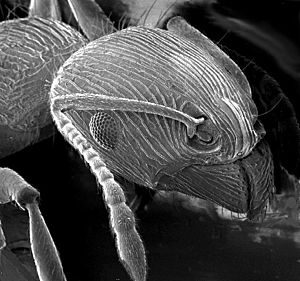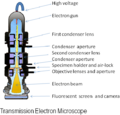Electron microscope facts for kids

An electron microscope is a powerful scientific tool that uses a beam of tiny particles called electrons to look at objects in incredible detail. Think of it like a super-magnifying glass! Regular microscopes use light, but light can only magnify things so much. Because electrons are much smaller than light waves, electron microscopes can magnify objects up to a million times, letting us see things that are about 1,000 times smaller than what a normal light microscope can show. The way electrons interact with an object helps create a picture that we can then see.
Contents
Types of Electron Microscopes
There are different kinds of electron microscopes, each designed for a specific way of looking at tiny things.
Transmission Electron Microscope (TEM)
A Transmission Electron Microscope, or TEM, works by sending a beam of electrons right through a very thin sample of what you want to see. Some electrons go through, and some bounce off. The electrons that pass through are collected and used to create a super-magnified image, sometimes up to 500,000 times bigger! This type of microscope is much more powerful than a regular light microscope.
Scanning Electron Microscope (SEM)
A Scanning Electron Microscope, or SEM, works a bit differently. Instead of shooting electrons through the sample, it scans a very narrow beam of electrons back and forth across the surface of the object. As the electrons hit the surface, they bounce off or get absorbed in different ways. The SEM detects these bouncing electrons and uses them to build up a detailed, 3D-like picture of the object's surface, piece by piece.
Scanning Transmission Electron Microscope (STEM)
The Scanning Transmission Electron Microscope, or STEM, combines the best features of both the TEM and the SEM. It offers the super-high magnification of a TEM, allowing you to see inside materials, but also gives you the excellent surface detail that an SEM provides. This makes the STEM very useful for doing advanced studies on materials that other microscopes can't do alone.
Images for kids
-
An early electron microscope built by Ernst Ruska in 1933
-
An image of Bacillus subtilis bacteria taken with an electron microscope from the 1960s
See also
 In Spanish: Microscopio electrónico para niños
In Spanish: Microscopio electrónico para niños








